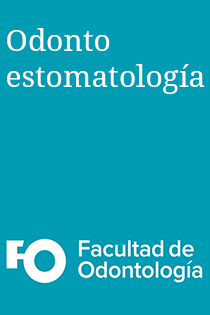Resumo
Objetivo: Determinar o efeito da intensidade de duas unidades de fotopolimerização na biocompatibilidade, resistência à flexão e módulo de elasticidade de uma resina composta.
Metodologia: Foram fabricados dois grupos de resina composta Filtek Z250XT, cada um deles foi fotopolimerizado com intensidades diferentes (<400 mW/cm2 por 40s e > 800 mW/cm2 por 20s). A viabilidade celular foi analisada por ensaio de MTT em 24 e 48 horas seguindo a norma ISO 10993-5. A resistência à flexão e o módulo de elasticidade foram analisados seguindo a norma ISO 4049.
Resultados: No grupo fotopolimerizado com intensidade <400mW/cm2, a citotoxicidade foi estatisticamente maior nas 24 e 48 horas e a resistência à flexão e o módulo de elasticidade foram estatisticamente menores.
Conclusão: Uma intensidade de polimerização <400 mW/cm2 aumenta os níveis de citotoxicidade e diminui as propriedades mecânicas das resinas compostas. Destaca-se a importância do controle periódico das unidades de fotopolimerização.
Referências
2.Fujioka-Kobayashi M, Miron RJ, Lussi A, Gruber R, Ilie N, Price RB, et al. Effect of the degree of conversion of resin-based composites on cytotoxicity, cell attachment, and gene expression. Dent Mater. 2019 Aug 1;35(8):1173–93.
3.Cohn-Inostroza N. Efecto citotóxico de BisGMA en cultivos celulares de fibroblastos humanos mediante ensayos de MTT. CLAVES Odontol. 2015;22(74).
4.International Organization for Standardization. ISO 10993-5 Biological evaluation of medical devices - Part 5: Tests for cytotoxicity: in vitro methods. 2009.
5.Alzraikat H, Burrow M, Maghaireh G, Taha N. Nanofilled Resin Composite Properties and Clinical Performance: A Review. Oper Dent. 2018 Jul 1;43(4):E173–90.
6.International Organization for Standarization, ISO 4049: 2019, Dentistry - Polymer-based restorative materials.
7.Yap AU, Eweis AH, Yahya NA. Dynamic and Static Flexural Appraisal of Resin-based Composites: Comparison of the ISO and Mini-flexural Tests. Oper Dent. 2018;43(5):E223–31.
8.Bragança GF, Vianna AS, Neves FD, Price RB, Soares CJ. Effect of exposure time and moving the curing light on the degree of conversion and Knoop microhardness of light-cured resin cements. Dent Mater. 2020;36(11):e340–51.
9.Małkiewicz K, Wychowański P, Olkowska-Truchanowicz J, Tykarska M, Czerwiński M, Wilczko M, et al. Uncompleted polymerization and cytotoxicity of dental restorative materials as potential health risk factors. Ann Agric Environ Med. 2017 Dec 23;24(4):618–23.
10.Selig D, Haenel T, Hausnerová B, Moeginger B, Labrie D, Sullivan B, et al. Examining exposure reciprocity in a resin based composite using high irradiance levels and real-time degree of conversion values. Dent Mater. 2015 May 1;31(5):583–93.
11.Aguiar TR, de Oliveira M, Arrais CAG, Ambrosano GMB, Rueggeberg F, Giannini M. The effect of photopolymerization on the degree of conversion, polymerization kinetic, biaxial flexure strength, and modulus of self-adhesive resin cements. J Prosthet Dent. 2015 Feb 1;113(2):128–34.
12.Chisini LA, Arangurem Karam S, Gioda Noronha T, Morello Sartori LR, Schmidt San Martin A, Demarco FF, et al. Platelet-Poor Plasma as a Supplement for Fibroblasts Cultured in Platelet-Rich Fibrin. Acta Stomatol Croat. 2017 Jun 15;51(2):133–40.
13.Romo-Huerta MJ, Cervantes-Urenda ADR, Velasco-Neri J, Torres-Bugarín O, Valdivia ADCM. Genotoxicity Associated with Residual Monomers in Restorative Dentistry: A Systematic Review. Oral Health Prev Dent. 2021;19(1):471–80.
14.Șaramet V, Meleșcanu-Imre M, Țâncu AMC, Albu CC, Ripszky-Totan A, Pantea M. Molecular Interactions between Saliva and Dental Composites Resins: A Way Forward. Materials (Basel). 2021 May 13;14(10):2537.
15.Schubert A, Ziegler C, Bernhard A, Bürgers R, Miosge N. Cytotoxic effects to mouse and human gingival fibroblasts of a nanohybrid ormocer versus dimethacrylate-based composites. Clin Oral Investig. 2019 Jan 30;23(1):133–9.
16.Saikaew P, Phimolthares P, Phitakthanaakul P, Sirikul P, Mekrakseree S, Panpisut P. Effects of Color Modifier on Degree of Monomer Conversion, Biaxial Flexural Strength, Surface Microhardness, and Water Sorption/Solubility of Resin Composites. Polymers (Basel). 2021 Nov 11;13(22):3902.
17.Borges MG, Silva GR, Neves FT, Soares CJ, Faria-e-Silva AL, Carvalho RF, et al. Oxygen Inhibition of Surface Composites and Its Correlation with Degree of Conversion and Color Stability. Braz Dent J. 2021 Feb 2;32(1):91–7.
18.Pagano S, Lombardo G, Balloni S, Bodo M, Cianetti S, Barbati A, et al. Cytotoxicity of universal dental adhesive systems: Assessment in vitro assays on human gingival fibroblasts. Toxicol In Vitro. 2019 Oct;60:252–60.
19.Beltrami R, Colombo M, Rizzo K, Di Cristofaro A, Poggio C, Pietrocola G. Cytotoxicity of Different Composite Resins on Human Gingival Fibroblast Cell Lines. Biomimetics. 2021 Apr 20;6(2):26.
20.Gonçalves F, Campos LM de P, Rodrigues-Júnior EC, Costa FV, Marques PA, Francci CE, et al. A comparative study of bulk-fill composites: degree of conversion, post-gel shrinkage and cytotoxicity. Braz Oral Res. 2018 Mar 8;32(0).
21.Sadeghyar A, Watts DC, Schedle A. Limited reciprocity in curing efficiency of bulk-fill resin-composites. Dent Mater. 2020;36(8):997–1008.
22.Grazioli G, Francia A, Cuevas-Suárez CE, Zanchi CH, Moraes RR De. Simple and Low-Cost Thermal Treatments on Direct Resin Composites for Indirect Use. Braz Dent J. 2019 Jun 3;30(3):279–84.
23.Bin Nooh AN, Nahedh H Al, AlRefeai M, Alkhudhairy F. The Effect of Irradiance on the Degree of Conversion and Volumetric Polymerization Shrinkage of Different Bulk-Fill Resin-Based Composites: An In Vitro Study. Eur J Dent. 2021 May;15(2):312–9.
24.Demarco FF, Corrêa MB, Cenci MS, Moraes RR, Opdam NJM. Longevity of posterior composite restorations: Not only a matter of materials. Dent Mater. 2012 Jan;28(1):87–101.
25.Vaidya N, Kumar P, Pathak K, Punia SK, Choudhary A, Patnana AK. Comparative Evaluation of the Influence of Different Sports/Energy Drinks and Alcoholic Beverages on the Surface Roughness of Three Different Flowable Esthetic Restorative Materials: An In Vitro Analysis. J Int Soc Prev Community Dent. 2020;10(5):585–90.
26.Fonseca ASQS, Labruna Moreira AD, de Albuquerque PPAC, de Menezes LR, Pfeifer CS, Schneider LFJ. Effect of monomer type on the CC degree of conversion, water sorption and solubility, and color stability of model dental composites. Dent Mater. 2017;33(4):394–401.
27.Cazzaniga G, Ottobelli M, Ionescu AC, Paolone G, Gherlone E, Ferracane JL, et al. In vitro biofilm formation on resin-based composites after different finishing and polishing procedures. J Dent. 2017 Dec;67:43–52.
28.Par M, Repusic I, Skenderovic H, Tarle Z. Wavelength-dependent light transmittance in resin composites: practical implications for curing units with different emission spectra. Clin Oral Investig. 2019 Dec 10;23(12):4399–409.


